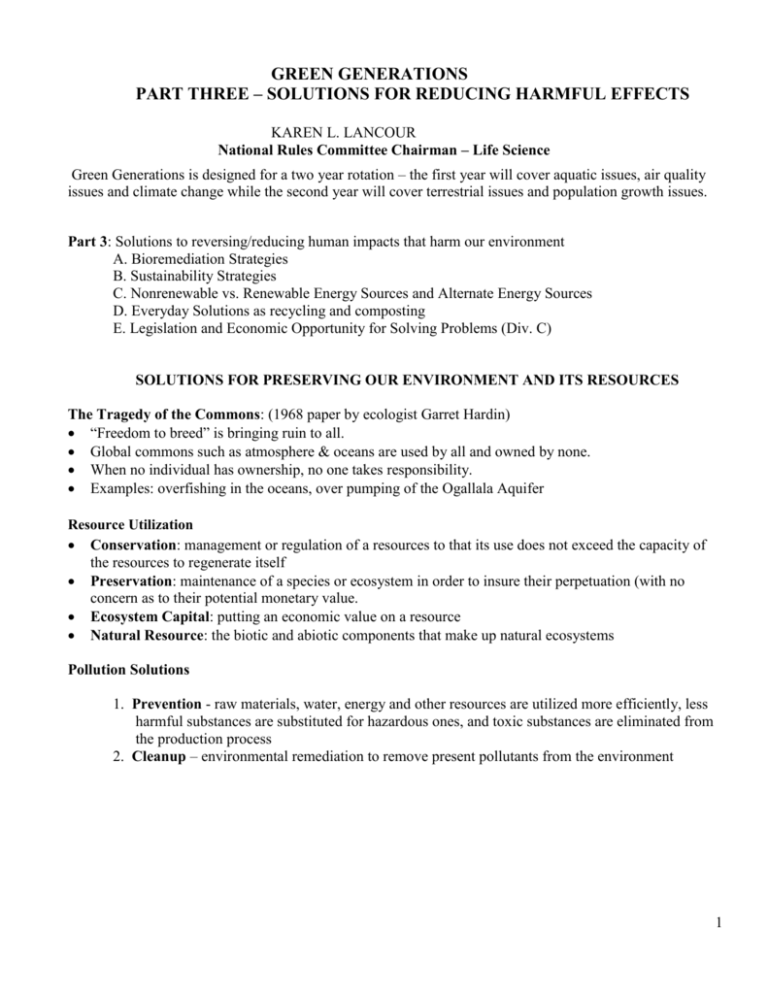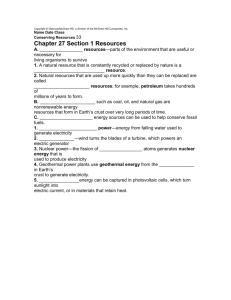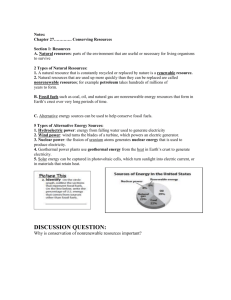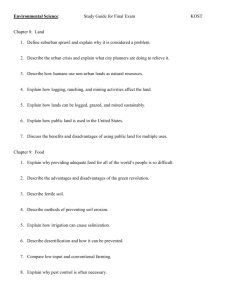green generations part three – solutions for reducing harmful effects
advertisement

GREEN GENERATIONS PART THREE – SOLUTIONS FOR REDUCING HARMFUL EFFECTS KAREN L. LANCOUR National Rules Committee Chairman – Life Science Green Generations is designed for a two year rotation – the first year will cover aquatic issues, air quality issues and climate change while the second year will cover terrestrial issues and population growth issues. Part 3: Solutions to reversing/reducing human impacts that harm our environment A. Bioremediation Strategies B. Sustainability Strategies C. Nonrenewable vs. Renewable Energy Sources and Alternate Energy Sources D. Everyday Solutions as recycling and composting E. Legislation and Economic Opportunity for Solving Problems (Div. C) SOLUTIONS FOR PRESERVING OUR ENVIRONMENT AND ITS RESOURCES The Tragedy of the Commons: (1968 paper by ecologist Garret Hardin) “Freedom to breed” is bringing ruin to all. Global commons such as atmosphere & oceans are used by all and owned by none. When no individual has ownership, no one takes responsibility. Examples: overfishing in the oceans, over pumping of the Ogallala Aquifer Resource Utilization Conservation: management or regulation of a resources to that its use does not exceed the capacity of the resources to regenerate itself Preservation: maintenance of a species or ecosystem in order to insure their perpetuation (with no concern as to their potential monetary value. Ecosystem Capital: putting an economic value on a resource Natural Resource: the biotic and abiotic components that make up natural ecosystems Pollution Solutions 1. Prevention - raw materials, water, energy and other resources are utilized more efficiently, less harmful substances are substituted for hazardous ones, and toxic substances are eliminated from the production process 2. Cleanup – environmental remediation to remove present pollutants from the environment 1 ENVIRONMENTAL REMEDIATION Environmental remediation is the removal of pollution or contaminants from the environment Strategies and techniques include (coordinated by EPA) Site assessment and mapping Excavation and dredging Pump and treat Solidification and stabilization Oxidation Soil vapor extraction Bioremediation – using microbes to remove pollutants Remediation for Water Pollution Involvement at many levels to prevent sources of pollution individuals communities industries states federal governments Stabilization of the ecosystem significant remedy to control water pollution the reduction in waste input harvesting and removal of biomass trapping of nutrients fish management aeration Reutilization and recycling of water industrial effluents (as paper pulp or other chemicals), sewage of municipal and other systems thermal pollutants (waste water etc.) may be recycled to beneficial use. Removal of pollutants Various pollutants (radioactive, chemical, biological) present in water body Using appropriate methods or remedy like adsorption, electro-dialysis, ion-exchange, reverse osmosis etc. 2 SUSTAINABILITY STRATEGIES Sustainability - biological systems enduring and remaining diverse and productive thus the ability to meet the current needs of humanity without compromising the ability of future generations to meet their needs and maintain the a healthy world environment Strategies include Minimize energy consumption & using alternate energy Minimize water consumption Minimize negative environmental impacts Minimize waste generation and recycling Develop eco-friendly products and processes Strategies for a Sustainable World advancing technologies to reduce waste increasing recycling and reuse creating even safer treatment and disposal options developing sources of renewable energy sharing the benefits of our learning and innovation Maintaining Biodiversity Conservation: allowing the use of resources in a responsible manner Preservation: setting aside areas and protecting them from human activities Keystone species: species whose role in an ecosystem are more important than others ( sea otters, sea stars, grizzly bears, prairie dogs) Indicator species: species that serve as early warnings that an ecosystem is being damaged ex. trout Characteristics of endangered species: small range, large territory, or live on an island Endangered species: a group of organisms in danger of becoming extinct if the situation is not improved; population numbers have dropped below the critical number of organisms; North spotted Owl (loss of old growth forest), Bald Eagle (thinning of eggs caused by DDT), Piping Plover (nesting areas threatened by development), and many others Invasive/Alien/Exotic species: non-native species to an area; often thrive and disrupt the ecosystem balance; examples: kudzu vine, purple loosestrife, African honeybee “killer bee”, water hyacinth, fire ant, zebra mussel, gypsy moth, Asian Long Horned Beetle 3 Controlling Pests Major insecticide groups (and examples): chlorinated hydrocarbons (DDT); organophosphates (malathion); carbamates (aldicarb) Pesticide pros: saves lives from insect-transmitted disease, increases food supply, increases profits for farmers Pesticide cons: genetic resistance, ecosystem imbalance, pesticide treadmill, persistence, bioaccumulation, biological magnification Biological Magnification of DDT Natural pest control: better agricultural practices, genetically resistant plants, natural enemies, biopesticides, sex attractants In natural ecosystems, methods which control 50-90% of pests: predators, diseases, parasites ENERGY General Potential vs. Kinetic Convection: transfer of heat by movement of heated matter Conduction: transfer of energy through matter from one particle to another Radiant Energy (sunlight) Units: joules, Calorie, BTU, kilowatt hour Power Units: watt and horse power Thermal gradient: spontaneous flow of heat from warmer to cooler bodies Ionizing radiation: enough energy to dislodge electrons from atoms, forming ions; capable of causing cancer (gamma, X-rays, UV) High Quality Energy: organized & concentrated; can perform useful work (fossil fuel & nuclear) Low Quality Energy: disorganized, dispersed (heat in ocean or air wind, solar) First Law of Thermodynamics: energy is neither created nor destroyed, but may be converted from one form to another (Law of Conservation of Energy) Second Law of Thermodynamics: when energy is changed from one form to another, some useful energy is always degraded into lower quality energy, usually heat Best solutions to energy shortage: conservation, increase efficiency, explore alternative energy options 4 Nonrenewable vs. Renewable Energy Sources Non-renewable energy sources – fossil fuels as coal, oil and natural gas as well as nuclear fuels – limited supply will run out and have negative environmental impacts Renewable energy sources – sun, wind, waves, heat, hydropower and biomass that can be used again and again and is cleanest energy sources. There are pros and cons for each type of energy Non-Renewable Energy-Fossil Fuel Fossil Fuel (64% of world’s electricity) Nuclear Energy (provides 17 % of world’s electricity) Renewable Resources (19% of world’s electricity) Petroleum: formed as sediments are buried and converted to rock, organic material in sediments are chemically transformed into petroleum through a process called maturation. Petroleum formation: microscopic aquatic organisms in sediments converted by heat and pressure into a mixture of hydrocarbons (animal remains) o Pros of petroleum: relatively cheap, easily transported, highquality energy o Cons of petroleum: reserves will be depleted soon; pollution during drilling, transport and refining; burning makes CO2 Crude Oil: underground petroleum Coal: black combustible rock Natural gas: a “by-product” of maturation and propane which is a mixture of natural gas and oil. 5 Hubbert Peak Theory: influential theory that concerns the long-term rate of conventional oil extraction and depletion. Predicts the future world oil production will soon reach a peak and then rapidly decline. (The peak is only identified after it has occurred) Types of Coal: anthracite: almost pure carbon; bituminous: second purest; and lignite: least pure Steps in coal formation: peat, lignite, bituminous, anthracite Wastes: SO2, flyash and boiler residue from coal burning Non-Renewable Energy – Nuclear Energy- Uranium Natural radioactive decay: unstable radioisotopes decay releasing gamma rays, alpha particles, and beta particles Half-life: the time it takes for ½ the mass of a radioisotope to decay Estimate of how long a radioactive isotope must be stored until it decays to a safe level: approximately 10 half-lives Nuclear Fission: nuclei of isotopes split apart when struck by neutrons Nuclear Fusion: two isotopes of light elements (H) forced together at high temperatures till they fuse to form a heavier nucleus (He). Process is expensive Mass deficit: not all matter is converted into matter in a fusion reaction – some (the mass deficit) is converted into energy. E = mc2. Explains the energy released in a fusion reaction. Major parts of a nuclear reactor: core, control rods, steam generator, turbine, containment building Most serious nuclear accidents: Fukushima Daiichi Disaster, Japan (2011), Chernobyl, Ukraine (1986) and Three Mile Island, PA (1979) 6 Pros and Cons of Non-Renewable Energy Pros o Cheap and easy to use o Small amounts of nuclear energy can produce large amounts of power o Have Little or no competition o Cheap when converting one type of energy to another Cons o Will expire some day o Can have serious environmental changes o Prices will go up as supply diminishes Electricity Cogeneration: using waste heat to make electricity Electricity generated by fossil fuels, biomass or nuclear power: heat is produced which creates steam - steam turns a turbine - the mechanical energy from the turbine is converted to electrical energy in a generator and that energy is transmitted to homes through power lines Hydroelectric power: potential energy of stored water is used to turn a turbine - the mechanical energy from the turbine is converted to electrical energy in a generator and that energy is transmitted to homes through the transformer to the transmission tower. Renewable Energy Biomass including o wood and wood waste o municipal solid waste o landfill gas and biogas o ethanol o biodiesel – waste vegetable oil Gasohol: Ethanol 85-90% gas and 10-15 % ethanol Hydroelectric: using water to move a turbine that powers a generator Solar: o Passive – widows facing the sun o Active – solar panels; photovoltaic cells collect sun energy through panels and directly store it into batteries Wind: Wind turns blades which are connected to gearbox and generator that controls the turbines Geothermal: capturing earth’s internal heat to heat water and turn turbines to create electricity Wave/Tidal Energy: newer and exploratory 7 Pros and Cons of Renewable Energy Pros o Wind, geothermal, ocean energy are available in abundant quantity and free to use o Have low carbon emissions and are environmentally friendly o Can potentially stimulate the economy and create jobs with state and federal government incentives Cons o Initial costs are very high and sustainability may be cost preventive o Often located in remote locations and building lines to urban areas is very expensive o Can have serious environmental changes as with geothermal energy which can bring toxic chemical from beneath the earth surface to the top and can create environmental changes o Hydroelectric provides clean energy but building dams is expensive and can affect natural river flow and affect wildlife o Wind power needs strong winds, can be expensive to set up and maintain as well as affecting bird populations o Cloudy days reduce solar power, calm days reduce wind power and droughts reduce water available for hydropower Alternate Energy Sources-Alternate to Fossil Fuels – produced and recovered without negative effects on the environment as: Alternate energy sources: wind, solar, waves, biomass, geothermal, fuel cells Solar Wind power Geothermal Tides and waves Biomass Fuel cells EVERYDAY SOLUTIONS Conserve Increase Efficiency Recycle Recycling - (Reduce, Reuse, Recycle) – A process to change waste materials into new products to prevent waste of potentially useful materials, reduce the consumption of fresh raw materials, reduce energy usage, reduce air pollution from incineration and water pollution from land filling by reducing the need for "conventional" waste disposal, and lower greenhouse gas emissions as compared to plastic production. Recyclable materials include many kinds of glass, paper, metal, plastic, textiles, and electronics. Compost- organic matter that has been decomposed and recycled as a fertilizer and soil amendment Benefits of Composting - a key ingredient in organic farming Soil Conditioner – create rich humus Recycles kitchen and yard waste Introduces beneficial organisms in the soil Good for the environment as a natural alternative to chemical fertilizers Reduces landfill waste 8 AGENCIES FOR ENVIRONMENTAL PROTECTION World - United Nations Environmental Program (UNEP) http://www.unep.org/ US - United States Environmental Protection Agency (EPA) http://www.epa.gov/ ECONOMIC OPPORTUNITIES – Div. C Support careers in Environmental Remediation and Green Jobs Development of Environmentally Safe Products and Processes which are economically sound Encourage Economic Growth that is environmentally beneficial The Green Economy Report is compiled by UNEP’s Green Economy Initiative in collaboration with economists and experts worldwide. It demonstrates that the greening of economies is not generally a drag on growth but rather a new engine of growth; that it is a net generator of decent jobs, and that it is also a vital strategy for the elimination of persistent poverty. http://www.unep.org/greeneconomy/Portals/88/documents/ger/ger_final_dec_2011/Green%20Economy Report_Final_Dec2011.pdf A guidebook to the Green Economy http://www.uncsd2012.org/content/documents/528Green%20Economy%20Guidebook_100912_FINAL.pdf The United States Bureau of Labor Statistics (BLS) http://www.bls.gov/ recently began measuring green jobs with the introduction in 2010 of their Green Jobs Initiative. This is an effort to gather data on "(1) the number of and trend over time in green jobs, (2) the industrial, occupational, and geographic distribution of the jobs, and (3) the wages of the workers in these jobs" (BLS 2012c). "The BLS defines green jobs as either: (1) Jobs in businesses that produce goods or provide services that benefit the environment or conserve natural resources, or (2) Jobs in which workers' duties involve making their establishment's production processes more environmentally friendly or use fewer natural resources" (BLS 2012c). Jobs are considered green if they produce goods or services directly related to: 1. Energy from renewable sources. 2. Energy efficiency. 3. Pollution reduction and removal, greenhouse gas reduction, and recycling and reuse. 4. Natural resources conservation, organic agriculture and sustainable forestry. 5. Environmental compliance and regulatory administration, education and training, and public awareness and advocacy. (BLS 2012c). According the first Bureau of Labor Statistics data, in 2010, 3.1 million jobs in the U.S. were associated with the production of green goods and services, accounting for 2.4 percent of total U.S. employment in that year. Of the total, 2.3 million jobs were in the private sector, and 860,300 in the public sector (BLS, Mar 2012, 1). Green Career Articles http://www.bls.gov/green/greencareers.htm#articles o Water Conservation o Sustainable Forestry o Biofuels o Geothermal Energy o Environmental Remediation o Sustainability o Energy Auditors o Recycling o Electric Vehicles o Green Construction o Solar Power o Wind Power 9 LEGISTATION AND POLICIES – Div. C International Treaties, Laws and Conventions IUCN( International Union for Conservation of Nature) International Red List of Endangered Species Convention on International Trade in Endangered Species (CITES): lists species that cannot be commercially traded as live specimens or wildlife products. Madrid protocol: Moratorium on mineral exploration for 50 years in Antarctica Kyoto Protocol of 1997: Controlling global warming by setting greenhouse gas emissions targets for developed countries. Not signed by the U.S. Montreal Protocol of 1987: A plan to limit and eventually phase out ozone depleting substances (CFC's) Earth Summit: held in 1970's, discussed clean water and air. Held in South Africa. The last summit tried to pass a world law by the year 2010 that 15% of our power was to be created by air and solar power. But the Summit was shut down. The World Trade Organization (WTO): designed to make international trade more fair and encourage development. It has been used to subvert national environmental laws. Has the effect of hurting small, local farmers and businesses. North American Free Trade Agreement (NAFTA): Trade alliance between U.S., Canada and Mexico Stockholm Convention on Persistent Organic Pollutants: (2004) Seeks to protect human health from the 12 most toxic chemicals (includes 8 chlorinated hydrocarbon pesticides / DDT can be used for malaria control Convention on International Trade in Endangered Species (CITES): (1973) lists species that cannot be commercially traded as live specimens or wildlife products KEY US ENVIRONMENTAL LAWS http://www2.epa.gov/laws-regulations/laws-and-executive-orders Clean Air Act (CAA) of 1970: established national primary and secondary air quality standards. Set emission standards for cars, and limits for release of air pollutants. Clean Water Act (CWA) of 1972: set maximum permissible amounts of water pollutants that can be discharged into waterways and created pollutant discharge permits. Goal: To make all water swimmable and fishable. Water Quality Act of 1965: attempt to reduce non-point source pollution by creating government watch dog under Dept of Heath, Ed and Welfare. Emergency Planning & Community Right-To-Know Act (EPCRA) Endangered Species Act : (1973) identifies threatened and endangered species in the U.S., and puts their protection ahead of economic considerations Federal Insecticide, Fungicide and Rodenticide Act (FIFRA) of 1947 regulates the manufacture and use of pesticides Freedom of Information Act (FOIA) National Environmental Policy Act (NEPA of 1969: Environmental Impact statements must be done before any project effecting federal lands is started. Created a council on environmental quality.) Occupational Safety and Health Act (OSHA) Oil Pollution Act of 1990 (OPA) Pollution Prevention Act (PPA) Resource Conservation and Recovery Act (RCRA) Safe Drinking Water Act (SDWA) of 1974: set maximum contaminant levels for pollutants that may have adverse effects on human health. Comprehensive Environmental Response, Compensation, and Liability Act (CERCLA or Superfund) 10 Superfund Amendments and Reauthorization Act Toxic Substances Control Act (TSCA of 1976: EPA- ban or regulate chemicals deemed a risk to the health of the environment.) Wilderness Act of 1964: established the national wilderness preservation system Endangered Species Act of 1973: protects threatened and endangered animals in the US, and puts their protection over economic considerations. Superfund Amendments and Reauthorization Act (SARA): increased superfund to $8.5 Billion. Shares responsibility for cleanup among potentially responsible parties. Resource Conservation & Recovery Act (RCRA) of 1976: Controls hazardous waste with a cradle to grave system from storage, treatment, transportation to disposal. Surface Mining Control & Reclamation Act of 1977 (SMCRA): requires coal strip mines to reclaim the land Comprehensive Environmental Response, Compensation and Liability Act (CERCLA) of 1980: Created $1.6 billion superfund designed to identify and clean up abandoned hazardous waste dump sites. Established liability for clean up costs if source could be identified. Ocean Dumping Ban Act of 1988: Bans dumping of sewage, sludge and industrial waste into oceans. Food Quality Protection Act of 1996 (FQPA0: Set pesticide limits in food, and all active and inactive ingredients must be screened for estrogenic/endocrine effects. Low Level Radioactive Policy Act: all states must have facilities to handle low level radioactive wastes. Nuclear Waste Policy Act: US government must develop a high level nuclear waste site by 2015 Coastal Zone Management Act (CZMA)- A 1972 Federal law that provides guidance and federal assistance to voluntary state and local coastal management programs. Goals are for the protection of natural resources and management of land development along coasts. Federal Land Policy and Management Act (FLPMA)- A 1976 Federal law that outlines procedures concerning the use and preservation of public US lands. Food Drug and Cosmetic Act- A federal law passed in 1906 that regulates the sanitary condition and safety of food, drugs and cosmetics. It includes food additives. Laws and Policies by Topic GENERAL National Environmental Policy Act: (1969) Environmental Impact Statements must be done before any project affecting federal lands can be started Pollution Prevention Act of 1990 "source reduction and other practices that reduce or eliminate the creation of pollutants through increased efficiency in the use of raw materials, energy, water, or other resources, or protecting resources through conservation" Stockholm Convention on Persistent Organic Pollutants: (2004) Seeks to protect human health from the 12 most toxic chemicals (includes 8 chlorinated hydrocarbon pesticides / DDT can be used for malaria control WATER Safe Drinking Water Act: (SDWA, 1974) set maximum contaminant levels for pollutants in drinking water that may have adverse effects on human health 11 Clean Water Act: (CWA, 1972) set maximum permissible amounts of water pollutants that can be discharged into waterways; aims to make surface waters swimmable and fishable Ocean Dumping Ban Act: (1988) bans ocean dumping of sewage sludge and industrial waste in the ocean AIR Clean Air Act: (CAA, 1970) set emission standards for cars and limits for release of air pollutants Kyoto Protocol: (2005) controlling global warming by setting greenhouse gas emissions targets for developed countries Montreal Protocol: (1987) phase-out of ozone depleting substances WASTE, SOLID AND HAZARDOUS Resource Conservation & Recovery Act (RCRA): (1976) controls hazardous waste with a cradle-tograve system Comprehensive Environmental Response, Compensation & Liability Act (CERCLA): (1980) “Superfund,” designed to identify and clean up abandoned hazardous waste dump sites Nuclear Waste Policy Act: (1982) U.S. government must develop a high level nuclear waste site (Yucca Mtn) Food Quality Protection Act (FQPA, 1996): set pesticide limits in food, & all active and inactive ingredients must be screened for estrogenic/endocrine effects MINING Surface Mining Control & Reclamation Act: (1977) requires coal strip mines to reclaim the land Madrid Protocol: (1991) Suspension of mineral exploration (mining) for 50 years in Antarctica Madrid Protocol: (1991) Moratorium on mineral exploration for 50 years in Antarctica LIFE Endangered Species Act: (1973) identifies threatened and endangered species in the U.S., and puts their protection ahead of economic considerations Convention on International Trade in Endangered Species (CITES): (1973) lists species that cannot be commercially traded as live specimens or wildlife products Magnuson-Stevens Act: (1976) Management of marine fisheries Healthy Forest Initiative: (HFI, Healthy Forests Restoration Act of 2003) thin overstocked stands, clear away vegetation and trees to create shaded fuel breaks, provide funding and guidance to reduce or eliminate hazardous fuels in national forests, improve forest fire fighting, and research new methods to halt destructive insects 12







